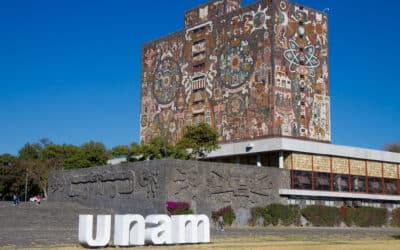You can’t fix the Earth with these geoengineering proposals, but you can sure make it worse.
by Raymond T. Pierrehumbert (Slate)

We would be insane to mess with the atmosphere. Photo illustration by Juliana Jimenez Jaramillo. Photo by Frank Bienewald/LightRocket via Getty Images
Some years ago, in the question-and-answer session after a lecture at the American Geophysical Union, I described certain geoengineering proposals as “barking mad.” The remark went rather viral in the geoengineering community. The climate-hacking proposals I was referring to were schemes that attempt to cancel out some of the effects of human-caused global warming by squirting various substances into the atmosphere that would reflect more sunlight back to space. Schemes that were lovingly called “solar radiation management” by geoengineering boosters. Earlier I had referred to the perilous state such schemes would put our Earth into as being analogous to the fate of poor Damocles, cowering under a sword precariously suspended by a single thread.
This week, the National Research Council (NRC) is releasing a report on climate engineering that deals with exactly those proposals I found most terrifying. The report even recommends the creation of a research program addressing these proposals. I am a co-author of this report. Does this mean I’ve had a change of heart?
No.
The nearly two years’ worth of reading and animated discussions that went into this study have convinced me more than ever that the idea of “fixing” the climate by hacking the Earth’s reflection of sunlight is wildly, utterly, howlingly barking mad. In fact, though the report is couched in language more nuanced than what I myself would prefer, there is really nothing in it that is inconsistent with my earlier appraisals.
Even the terminology used in the report signals a palpable change in the framing of the discussion. The actions discussed for the most part are referred to as “climate intervention,” rather than “climate engineering” (or the common but confusing term geoengineering). Engineering is something you do to a system you understand very well, where you can try out new techniques thoroughly at a small scale before staking peoples’ lives on them. Hacking the climate is different—we have only one planet to live on, and can’t afford any big mistakes. Many of the climate “engineering” proposals are akin to turning the world’s whole population into passengers on a largely untested new fleet of hypersonic airplanes.
Most previous literature has referred to schemes to increase the proportion of sunlight reflected back to space as solar radiation management, as if it were something routine and businesslike, along the lines of “inventory management” or “personnel management.” It is far from clear, however, that solar radiation can be managed in any meaningful sense of the word. The NRC report instead uses the more neutral term “albedo modification.” Albedo is the scientific term for the proportion of sunlight reflected back to space. If the Earth had 100 percent albedo, it would reflect all sunlight back to space and be a frozen ice ball some tens of degrees above absolute zero, heated only by the trickle of heat leaking out from its interior. Earth’s current albedo is about 30 percent, with much of the reflection caused by clouds and snow cover. I myself prefer the term “albedo hacking,” but “albedo modification” does pretty well. My colleague and report co-author James Fleming has called such schemes “untested and untestable, and dangerous beyond belief.” (A companion report also discusses less problematic, if currently expensive, schemes for removing carbon dioxide from the atmosphere. Many of those would be well worth doing if they ever became economical.)
The report describes albedo modification frankly as involving large and partly unknown risks. It states outright that albedo modification “should not be deployed” and emphasizes that the main focus in climate protection should continue to be reduction of CO2 emissions. If we continue to let CO2 build up in the atmosphere and attempt to offset the effects by increasingly extreme albedo modification, the report states, that situation is one of “profoundly increasing risk.” This is a far cry from the cartoonish portrayal of albedo modification as the cheap and obvious method of choice in Superfreakonomics or by Newt Gingrich.
Two albedo modification schemes are singled out for detailed scrutiny. The first of these, called stratospheric aerosol modification, works high up in the atmosphere—in the layer known as the stratosphere—and involves injecting substances such as sulfur dioxide that lead to the creation of tiny particles that scatter sunlight back to space. It’s modeled on what happens in the wake of large volcanic eruptions. The second, called marine cloud brightening, works close to the Earth’s surface and involves injection of particles (usually created from salt spray) that either directly reflect sunlight or modify low-level clouds in a way that makes them more reflective. Both techniques have the glaring problem that the albedo-modifying effects disappear within a few weeks to a few years, whereas the climate effects of the CO2 we emit will persist for millennia, even if we ultimately kick the fossil fuel habit. That means that if the CO2 we have emitted at some time heats the Earth to the point where something intolerably bad starts to happen, active albedo modification would need to be continually maintained basically forever. When has humanity ever managed to sustain a concerted complex technological enterprise for centuries, let alone millennia? An awful lot can happen in a thousand years, much of which we have no way to anticipate. The report recognizes that such a millennial commitment would be unprecedented in human history.
The take-home message is that it is not possible to use albedo modification to counteract peak CO2-induced warming without maintaining the climate intervention without interruption for millennia. At least, that’s the case unless we learn how to actively suck CO2 out of the atmosphere. The problem of millennial commitment makes it exceedingly imprudent to count on albedo modification to get and keep us out of a climate emergency. Absent effective CO2-removal techniques, albedo modification cannot be seen as a temporary measure that can give us time to get our act together to eliminate CO2 emissions. And if at any point albedo modification actions are ceased abruptly, the world would be faced with the rapid release of a century or more of pent-up warming. This is why I refer to such a world as “Damocles world.” A lot could happen in a thousand years that might force abrupt termination of albedo modification, but to just mention one possibility: Think of what an attractive target most of the proposed deployment systems (e.g. tethered balloons or fleets of lumbering stratospheric aircraft) would be for terrorists, or for nations who believe rightly or wrongly that they are being harmed by albedo modification.
Temporary deployment scenarios, which are used to delay warming rather than limit its ultimate magnitude, are also considered in the report, which takes no stance on what form of deployment is most likely if the world is ever driven to that stage. I myself think the temporary deployment scenarios are highly implausible, and are mainly shopped by albedo-modification boosters as a less threatening way to get the camel’s nose in the tent. I think that if people realized how little albedo modification can do for climate without taking on a millennial commitment, and that even such modest goals come within reach only when CO2 emissions reductions are so successful you hardly need albedo modification at all, a lot of the enthusiasm for the technology—already feeble outside the small circle of boosters—would evaporate.
Albedo hacking in the face of high CO2 would put the Earth in a state that has no real analogue in all of human history. In fact, the state you create by such an action is somewhat like the state the Earth was in some 250 million years ago during the Permian period, when the sun was dimmer but atmospheric CO2 was higher. A more disturbing comparison involves what would happen if albedo hacking ends abruptly: That would risk warming of a magnitude unseen since the Paleocene-Eocene rapid warming event some 55 million years ago, but at a rate that is probably unprecedented in all of Earth history. The hacking would also transform a substantial amount of direct sunlight into diffuse sunlight, altering the environment for all green plants on land.
More generally, the climate of the Earth is determined by a struggle of two different parts of our planetary energy budget. One part is heat energy loss to space; CO2 affects that. The other part is the amount of sunlight absorbed; albedo modification affects that, but the consequences of turning this dial are not at all equivalent to dialing back CO2 to pre-industrial values. This dial can probably be used to reduce global mean temperature (though with uncertain precision), but there is much more to climate than that. The global cooling that could possibly be achieved comes at the cost of changes in rainfall patterns, winds, and regional temperature. With the current state of climate models, we have only very limited confidence in our ability to predict the outcomes, and even more limited ability to model the actual albedo change resulting from the complex chain of events due to an actual climate-intervention action. What’s more, our current ability to even monitor what we actually did to the sky leaves a lot to be desired. And albedo modification does little or nothing to ameliorate the acidification of the oceans caused by CO2 emissions. All that is acknowledged frankly in the report.
In other words, albedo modification addresses (albeit imperfectly) the symptoms but not the root causes of CO2-induced global warming. As a possible response to such criticisms, Oxford’s Steve Rayner has mused that “Band-Aids are useful when you are healing.” However, Band-Aids are not all that useful if you really needed penicillin instead, and the wound festers until you die. Albedo modification is not like a bandage that promotes healing, but more like taking painkillers when you really need surgery for cancer.
It could be argued with some justification that if we do not severely restrict CO2 emissions, future generations will not have the choice to pursue a climate that is roughly similar to conditions before the Industrial Revolution. The relevant comparison, according to this argument, isn’t between the albedo-modified state and the pre-industrial state, but rather between a hot, high-CO2 state and a generally cooler (on average) albedo-modified state. That’s the “lesser of two evils” argument, and the associated justification for research is called “arming the future.” It is not hard to imagine a future world where albedo modification becomes a matter of survival (at least until something happens to force an abrupt termination). Unrestrained CO2 emissions could render large parts of the Earth uninhabitable for large mammals (including us) outdoors, and it is not hard to imagine a panicked rush to embrace albedo modification in such a situation. The problem with the arming the future argument, as pointed out by philosopher Stephen Gardiner, is that the lesser of two evils is still an evil, and the greatest moral culpability of all falls on those who, as in the case of the tragic Sophie’s choice, put somebody in the position where they have no alternative but to make an evil choice. That is precisely what we would be doing to future generations if we continue to shirk our responsibility for restraining CO2 emissions.
The moral culpability issue is compounded by the fact that even a limited deployment of albedo modification, by removing some of the more palpable symptoms of climate disruption, would almost certainly remove some of the incentives for doing the hard things needed to decarbonize the economy. To the extent that research brings such deployments closer to reality, even that research can incur risks that move us farther along the spectrum of moral culpability.
Now, about those research recommendations: If albedo modification is such a terrible idea, why do research on it at all? Indeed in his book, Mike Hulme considers the technology ungovernable and argues that if a technology is basically ungovernable at the level of deployment, we shouldn’t be doing research that could bring it into being. The new NRC report’s specific research recommendations are actually quite cautious, focusing primarily on things that contribute to a better understanding of climate in general, in addition to being necessary prerequisites for a better-informed judgment of the risks of albedo modification. That includes research priorities such as a better understanding of clouds, better understanding of tropical precipitation changes, and better monitoring of the Earth’s energy budget (including those things needed to understand the response of climate to volcanic eruptions).
Going beyond fairly uncontroversial research of this type engages value judgments well outside of what a group of 16 scientists such as ours is equipped to decide, and goes well beyond the boundaries of scientific judgment itself. The report recommends, of necessity rather diffusely, the initiation of a “serious deliberative process” which would ultimately determine the nature of the research program and how it would be governed. I intend to be quite vocal in this process, if it ever gets underway. Some others on the committee no doubt have different ideas about what the outcome of the process should be. For example, a recent Nature opinion piece unconnected with the NRC report itself but co-authored by Granger Morgan (another of the NRC panel members) argues that research should initially proceed without any governance, at the discretion of the scientists involved. I guess Granger and I will have to duke that out as part of the “serious deliberative process” recommended by the NRC.
The real consequences of NRC recommendations for research would only be settled as part of the serious deliberative process the report recommends, and that is where the hard work and hard decisions will take place. It’s not at all clear how this is going to happen. In the United States, can we actually have a reality-based, serious deliberative process about anything anymore? Can a serious deliberative process about climate change materially involve a Congress that cannot even muster a Senate majority to agree that humans can and are changing the climate? With the present state of leadership (and not just in the United States), developing albedo-modification technology would be like giving a loaded gun to a child. (OK, in the U.S. some people actually do that; it doesn’t mean it’s a good idea.)
So yes, albedo hacking is still barking mad, but people are often driven to do barking mad things out of desperation, and we are heading to the breaking point now with our continued fossil fuel binge. But if it comes to albedo hacking, the result won’t be pretty. It won’t be some benign “Plan B,” but more like the constant fear of thermonuclear holocaust I grew up with during the Cold War. It will be the end of blue skies and crystal-clear starry nights, and the beginning of nightly blood-red sunsets. These are not the most serious consequences of albedo hacking, but they will serve as nightly visible proof of our moral failure. And there will be no exit, not for thousands of years (unless we figure out a way to suck CO2 out of the atmosphere). If the serious deliberative process counseled by the NRC report makes people stop and think about just how terrifying that world would be, perhaps the thought of a world with less reliance on fossil fuels would start to seem a lot less scary.



